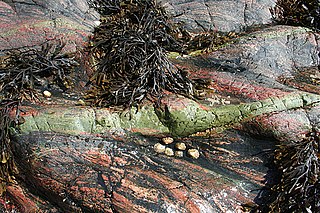Top Qs
Timeline
Chat
Perspective
Metamorphic reaction
From Wikipedia, the free encyclopedia
Remove ads
A metamorphic reaction is a chemical reaction that takes place during the geological process of metamorphism wherein one assemblage of minerals is transformed into a second assemblage which is stable under the new temperature/pressure conditions resulting in the final stable state of the observed metamorphic rock.[1]

Examples include the production of talc under varied metamorphic conditions:
- serpentine + carbon dioxide → talc + magnesite + water
- chlorite + quartz → kyanite + talc + water

Remove ads
Polymorphic transformations
This section is empty. You can help by adding to it. (June 2019) |
Exsolution reactions
This section is empty. You can help by adding to it. (June 2019) |
Devolatilization reactions
This section is empty. You can help by adding to it. (July 2019) |
Continuous reactions
This section is empty. You can help by adding to it. (June 2019) |
Ion exchange reactions
This section is empty. You can help by adding to it. (June 2019) |
Oxidation/reduction reactions
This section is empty. You can help by adding to it. (June 2019) |
Reactions involving dissolved species
This section is empty. You can help by adding to it. (June 2019) |
Chemographics
This section is empty. You can help by adding to it. (June 2019) |
Petrogenetic grids
This section is empty. You can help by adding to it. (June 2019) |
Schreinemaker's method
This section is empty. You can help by adding to it. (June 2019) |
Reaction mechanisms
This section is empty. You can help by adding to it. (June 2019) |
See also
Notes
Wikiwand - on
Seamless Wikipedia browsing. On steroids.
Remove ads
